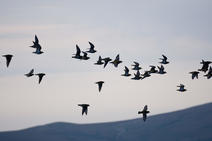A head-count of birds that live on Peak District National Park moors will take place this summer, for the first time in 14 years.
The vast landscape provides a vital home to special birds. These include golden plover, curlew, merlin, twite, dunlin, short-eared owl, red grouse, skylark, and meadow pipit.

In collaboration with Peak District land owners and land managers, Natural England and other organisations that make up the Moors for the Future Partnership are carrying out the breeding bird survey across the area. It was last undertaken in 2004, and before that in 1990.
The new review is being done to find out how factors including land use and management practices, as well as different habitat types on the moors, can influence bird populations. Part of this understanding will come from analysing survey results, and comparing them to the two previous studies. Through its Community Science project, the Partnership is also working to collect long-term data about how moorland birds are affected by climate change, including adapting to changing weather.
‘Moor’ effort to improve birds’ homes
Natural England is contributing more than half of the £140,000 funding for the project, with the Moorland Association giving £25,000. In addition, donations come from other partners: National Trust, RSPB, Severn Trent Water, United Utilities and Yorkshire Water. They are also working alongside the British Trust for Ornithology (BTO) to secure additional funding.
Much of the Peak District moorland that was surveyed in the previous studies was black and degraded, because of wild fires and historic pollution from nearby towns and cities.
In 2003, Moors for the Future Partnership started its work to help conserve and protect the area. Over the years, it has helped land managers to turn the moorlands bright and colourful once again. Native plants now grow, including bright green sphagnum moss, rich seeds and berries, and florid heather.
These changes are crucial for other benefits like improving drinking water, slowing down rainfall runoff to help reduce the risk of flooding, and storing carbon.
The Partnership is commemorating its 15th anniversary this year with 15 celebratory occasions throughout 2018. This latest breeding bird survey is one of them.
Feathered findings
Surveying will take place across approximately 500 square kilometres of Peak District moorland - around the size of 70,000 football pitches! It will be undertaken by experts during the bird breeding season from April to June.
Surveyors will visit each site twice during the project. One person will undertake assessments at any one time to avoid disturbing the nesting birds. They will walk in a zig-zag across each 500x500m survey square, to record the presence and behaviour of birds. Survey analysis will then be undertaken by the BTO.
Partnership power
Chris Dean, head of programme delivery at the Moors for the Future Partnership, said: “This flagship project comes at a special time as the Partnership is celebrating its 15th anniversary this year. The Peak District moors have changed enormously since 2003. There has been a huge amount of collaborative investment to improve the condition of these habitats.
“Bird populations here are of international importance because some are so rare. They are also a very positive part of peoples' moorland experience. We want to understand how different factors may be affecting these special species and what we can do to help them.”
Richard Pollitt from Natural England added: “We are delighted to support this vitally important study. It will tell us a lot about how moorland birds have been faring over the last 14 years. We hope it will also help determine what action will best protect these birds in the future.”
Keep up to date on the Partnership's 15th anniversary celebrations via social media: #MFFP15